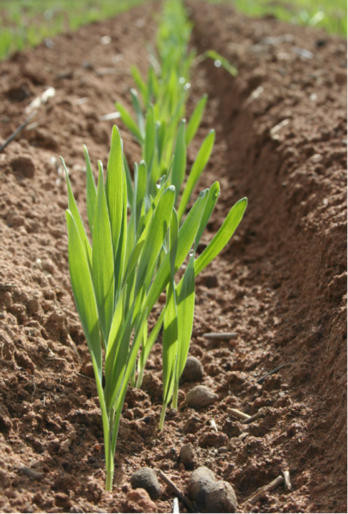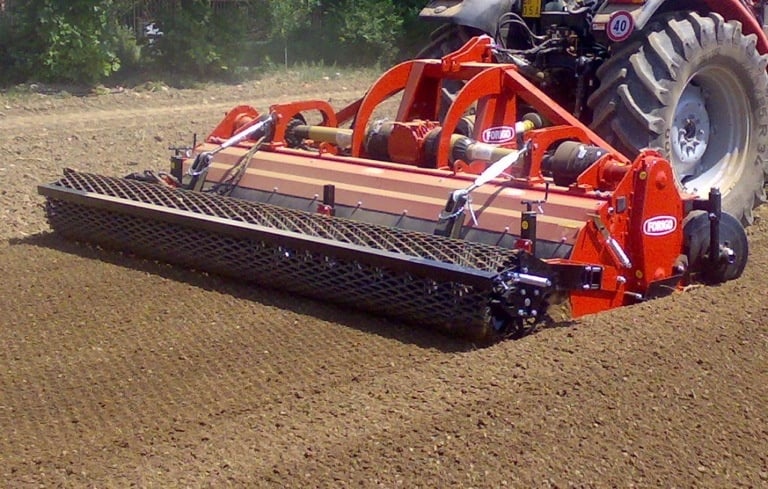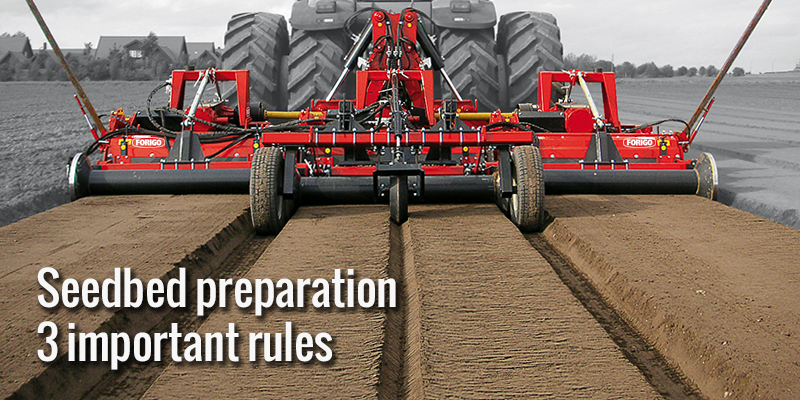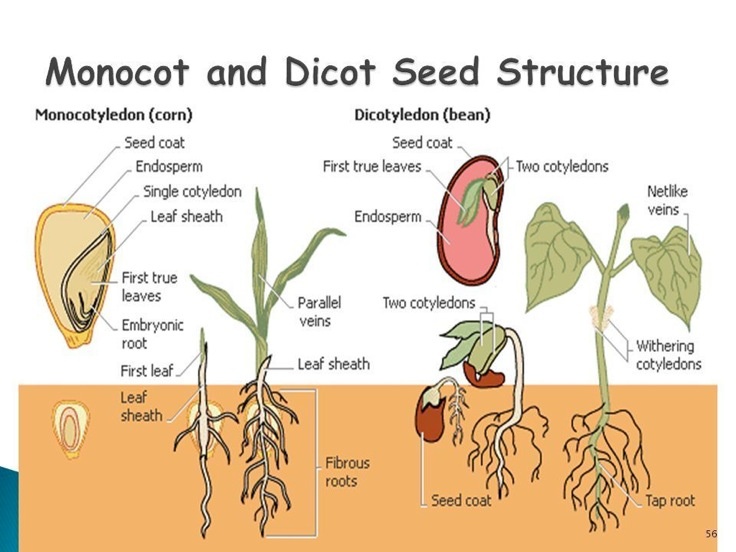News
Seedbed preparation: 3 rules to achieve perfect results
News _ 30 NOVEMBER _2018
The seedbed preparation is one of the most important step while working on the soil, because its effect can affect the growth of the crop. This operation depends on several factors. Let’s analyze together which rules you should follow in order to achieve perfect results.
According to some research, agriculture was born lots of centuries ago and it brought to the abandon of nomadism for the construction of villages. The activity which represents the borderline between “hunters” and “farmers” is the seeding of some plants useful to sustain and complete human’s diet. This transition found its origin in the fertile crescent, where lots of species grew spontaneously. The first cultivated crops were probably barley and spelt, maybe wheat (for grass family), lentil, chickpea, pea and vetch (for legumes). Thanks to the seeding, it was possible to grow more and more species. The seeding needs a preliminary preparation of the soil, in order to create a suitable environment for the seed to grow. Now we’ll see how it’s possible to create a seedbed by analyzing the right conditions which allow the development of the seed.
Conditions for the germination
For its growth, the seed needs heat, water and oxygen in a soil which allows the coleoptile (grass) and cotyle (legumes) the achievement of the sunlight. The real germination phase doesn’t need sunlight because the energy and the matter useful to cover the starting needs are provided from the nutritive supplies in the seed. There are two types of species: positive photosensitivity species which need the sunlight to activate the process of germination; negative photosensitivity species, they can develop the germination without sunlight. However 
The temperature can change from one species to another. In moderate weather conditions, ideal temperatures are between 18 and 24°C. For Autumn growing like barley and tender wheat, the temperature can be only a few degrees above zero. The species which grow in Spring (normally these are tropical or subtropical as soy and bean) need a specific temperature. Corn needs at least 12 °C for a regular and fast germination.
The temperature of the soil it’s important for Spring crops because after a cold season the species are more demanding. In order to “warm up” the land it’s necessary to work on it, the work reduces the presence of leftover which can cover the surface by slowing down the evaporation and the heat for irradiation. In addition to this, soil work facilitates the evaporation of water: a dry land has less thermal inertia and it warms up quickly than a wet land. A warm land allows to anticipate Spring seeding.
For the beginning and the success of the germination process, the water in the soil has to be enough and reach the embryo of the seed; besides, it has to be available during the entire process until the development of the roots, because they can swallow water also with active mechanism.
The third factor for the germination is oxygen which has to be available inside the land. With the break of the protective tegument caused by the absorption of water, the oxygen soaks into the seed and allows the metabolism of germination, the aerobic cycle of Krebs and the protein-based synthesis of other substances.
The structure of the soil should allow the protrusion of the rootlet and the growth of the crop, which emerges from the soil and creates its first leaves (this crop is called “ipocotile” when from the soil emerges the cotyledon; “epicotile” when the cotyledon stays buried under the soil). It’s important that the small plant reaches the atmosphere before finishing the stock of nutrients. When the cotyledon emerges from the soil, the photosynthesis can start: the development of leaves and roots allows the plant to improve its growth.
Ideal Seedbed
From these information you can understand the importance of a good seedbed.
First of all, the soil must have a good rate of humidity in order to keep the seed in contact with the water, this can activate the enzyme for the germination.
If a soil is too stressed from work, it can become dry (in Spring and in Autumn it is a common problem in the Mediterranean Region). A soil which has never been treated before, can be cold (in Spring this aspect affects the continental areas and north of Europe). In both cases it’s necessary to slow or delay the seeding. In order to obtain a good result, it’s important to carry out a non-excessive level of work during the soil preparation.
The excessive water has to drain and this operation is possible when there is a good permeability of macropores and the soil is free from surfaces which can block (or slow down) the infiltration of water. When there is a lack of water, it can emerge due to the wicking if underlying layers through macropores. Here again the presence of a surface can be an obstacle for the capillarity.
Since the germination and the entire biological development need a balanced relationship between air and water, it’s very important that the water circulate through in the soil. An efficient preparation of the soil allows a good structure of the land, which produces a balanced interaction between micro and macropores, this is the only state in which air and water can circulate.
The creation of an exterior crust obstructs the emergence of little plants. In lands full of loam and clay, the exterior crust is caused by the production of subtle soil during the seedbed preparation when weather conditions are dry. In this way, there is the creation of a resistant layer of soil which obstructs the emergence of the crop. Some machines, for example rotary tillers, tend to crush all the clumps.
In order to avoid the creation of the exterior crust and guarantee a balanced interaction between micro and macropores (the ideal condition is around 50%) it’s necessary to reduce the intensity of work during the seedbed preparation. To achieve this purpose, do not carry out operations which can create turmoil in the soil and clumps. Besides, it’s useful to carry out the intervention of refining, after the main process. In this way you obtain the refining with a minimized work which can respect the structure of the soil.
Roots have a strong infiltration: the extremity is protected by a resistant cover and proceeds by creating space in order to develop itself into the soil. When water and air infiltrate through the land, difficult soils are not a threat for the growth of plants even if they’re not treated.
Suggestions for the seedbed preparation
The preparation of the seedbed gets more difficult when the soil is full of loam and clay. In this lands, soil preparation can have positive or negative effects: sometimes it is an accomplice of the creation of antithetical conditions to those described, useful to guarantee the germination and the release of the crop.
There is another important aspect to considerate: the dimension of the seed from which depends the germination and the depth of the seeding. In order to bury the seed in the soil, the depth has to correspond to a multiple of the seed’s diameter: from 2 to 5 times. Some problems can be seen when you work with tiny seeds.
The dimension of seeds changes from different species. Extensive crops (for example cereals) have big seeds while forage and legumes have tiny seeds. Vegetable crops (for example carrot, setwall, chicory, lettuce) have tiny seeds, but the record for the tiniest seed regards the camomille (0,04 g/1.000 seeds!).
|
Herbaceous species |
Middelweight 1.000 seeds, g |
|
Herbaceous species |
Middelweight 1.000 seeds, g |
|
Allium cepa – Onion |
3,60 |
|
Helianthus annus – Sunflower |
80,00 |
|
Allium porrum – Leek |
2,70 |
|
Hordeum vulgare – Barley |
45,00 |
|
Arachis hypogaea – Peanut |
60-100 |
|
Lactuga sativa – Lettuce |
0,90 |
|
Asparagus officinalis – Asparagus |
20,00 |
|
Lens culinari – Lentil |
50,00 |
|
Avena sativa – Oat |
33,00 |
|
Lupinus luteus – Yellow lupin |
150,00 |
|
Beta vulgaris – Beetroot |
20,00 |
|
Lycopersicum lycopersicum – Tomato |
2,70 |
|
Brassica chinensis – Cabbage celery |
2,50 |
|
Matricaria chamomilla – Camomile |
0,04 |
|
Brassica napus – Rape |
4,00 |
|
Medicago sativa – Lucerne |
2,00 |
|
Brassica oleracea – Cabbage |
3,00 |
|
Nicotiana tabacum – Tobacco |
0,07 |
|
Brassica senape – Black mustard |
2,00 |
|
Ocimum basilicum – Basil |
1,40 |
|
Cannabis sativa – Hemp |
20,00 |
|
Origanum vulgare – Oregano |
0,20 |
|
Capsicum spp – Capsicum peppers |
6,50 |
|
Oryza sativa – Rice |
28-45 |
|
Cicer ariethinum – Chickpea |
400,00 |
|
Phacelia tanacetifolia – California bluebell |
2,00 |
|
Cichorium endivia – Endive |
1,30 |
|
Phaseolus vulgari – Bean |
200-600 |
|
Cichorium intybus – Radicchio |
1,30 |
|
Pisum sativum – Pea |
200-300 |
|
Cynara scolymus – Artchocke |
55,00 |
|
Raphanus sativus – Radish |
8,00 |
|
Cynara cardunculus – Cardoon |
35,00 |
|
Secale cereale – Rye |
27,00 |
|
Citrullus lanatus – Watermelon |
100,00 |
|
Sinapis alba – White mustard |
6,00 |
|
Cucumis melo – Cantaloupe |
30,00 |
|
Solanum melongena – Eggplant |
3,80 |
|
Cucumis sativus – Cucumber |
30,00 |
|
Spinacia oleracea – Spinach |
11,00 |
|
Cucurbita maxima – Pumpkin |
250,00 |
|
Triticum aestivum – Common wheat |
38,00 |
|
Cucurbita pepo – Zucchini |
150,00 |
|
Triticum durum – Durum wheat |
50,00 |
|
Daucus carota – Carrot |
0,85 |
|
Triticum spelta – Spelt |
55-105 |
|
Fagopyrum esculentum – Buckwheat |
20,00 |
|
Valeriana officinalis – Valerian |
1,20 |
|
Foeniculum vulgare – Fennel |
3,50 |
|
Valerianella locusta – Valerianella |
2,00 |
|
Glycine max – Soy |
120-180 |
|
Vicia faba – Fava bean |
400-2000 |
|
Gossipium spp. – Cotton |
125,00 |
|
Zea mays – Corn |
100-500 |
Seedbed preparation for extensive crops
The previous seedbed, characterized by thin soil where every tool could drop off the seed, is replaced by a rough land, with crops leftovers (with a view to sustainable agriculture). A rough land is safe from the creation of an external crust, it reduces evaporation and encourages the emergence of plants.
The three useful rules to make a good seedbed for extensive crops are:
- Delete the surface and the prints produced by the passage of the machine. You can carry out these operations by using light interventions in order not to modify the natural layer of land. Please carry out the operation only when the land needs it and the depth of the work must be 10-15 cm from the surface and prints;
- For Autumn crops carry out a treatment on the surface with a maximum depth of 10 cm, while for Spring crops you can stay between 10 and 15 cm. With a plentiful crops leftover you can move up the intervention in order to support the decomposition of this leftover by mixing it in the surface of the land. The move up of the intervention allows you to apply the procedure of stale seedbed;
- When the seedbed preparation has been moved up compared to the seeding, the weeds can sprout. This can make the control easy, which can be chemical or, better, mechanical. In this case you can work on a few centimeters of depth to devitalize weeds, stop the evaporation of water and avoid the creation of the external crust.
Seedbed preparation for vegetable crops

Here it is useful to create a thin layer of land where the seed will be buried (approximately from 1 to 3 cm). To preserve the structure of the land, it’s necessary to use equipment which can limit corrosive action on the soil.
The three useful rules to make a good seedbed for vegetable crops are:
- Delete the surface and the prints produced by the passage of the machine, by using specific compactors with anchors which don’t turn the soil upside down in order not to modify the natural layer of land. Please carry out the operation only when the land needs it and the depth of the work must be 10-15 cm from the surface and prints;
- Directly on a compact soil, you can work with the machine stone burier in a depth of 10-15 cm if there are not stones, leftovers or cover crops. A deeper treatment (15-20 cm) if the previous elements are to be seen. The stone burier machine can keep the thin soil on surface by sending deep down clumps and leftovers. It has a particular mode of operation: it can reduce the negative actions in the soil;
- When you see lots of cover crops or leftovers, it’s important to anticipate the work with the stone burier, in order to “refresh” the seedbed by working on the surface.
Conclusion
The seedbed preparation has a very important role. You should pay the right attention because this is what can make the difference between a good and a bad production.
We hope this article has been useful for you. If you have any doubt or interest in Forigo’s products, please contact us! Our experts are always at your disposal.

Research and Development Division of Forigo Roteritalia. Team of experts engaged in the study and analysis of the main agricultural and horticultural techniques used today. Knowledge combined with competence are the starting point for continuous improvement in a scenario of innovation and technological development.
Upcoming Exhibitions
Previous Exhibitions
30 MARCH 2025
Forigo at Agriumbria 2025: quality in soil preparation
07 FEBRUARY 2025
Forigo at Fruit Logistica 2025: towards more efficient agriculture













